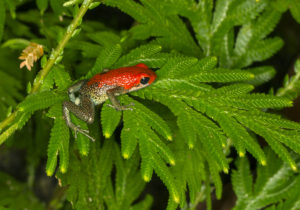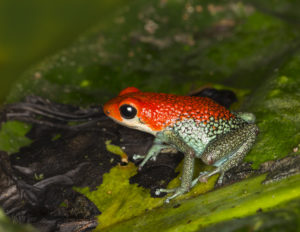Walking quietly along the trail to the waterfall on a wet day, it isn’t hard to hear the soft trilling call of the Granular Poison Dart Frog, Oophaga granulifera. This diminutive frog can be quite difficult to find, but a search in the right areas will yield several. One spot is past the turnoff for Casa Paraiso, down the hill, and on the right you’ll see a faucet among some rocks. Look around here, on the rocks and nearby leaves, and you may find as many as three of these ¾ inch-long bright-red frogs. Another good place is around the last set of steps down to the waterfall. Go past the open treefall, down a set of steps, and just as you approach an overlook for the waterfall, check the larger leaves and rocks above this viewing site.

You may have heard of the “Blue Jeans Frog” or “Strawberry Poison Dart Frog” which is a close relative of our species. The Granular Poison Dart Frog has rougher skin and a green cast to its legs. It is also the rarer of the two species, with a smaller range and a preference for streams through mature forest. Interestingly, a little farther north in Costa Rica, these same frogs are green in color and much more reclusive.
So, why are these frogs so brightly colored? The reason is thought to be that predators will learn to avoid a bad-tasting or poisonous species and avoid it. Birds in particular can learn very quickly to select prey that has a certain color and taste. So being red is a warning – I make you sick! The Granular Poison Dart Frog is not as toxic as some of the South American species (one of which is so poisonous a single tiny frog can kill 20,000 mice). It is important to avoid handling these frogs, as any cuts you might have would be irritated.
The frogs you encounter are most likely to be males that are calling to maintain their territory (they will fight with other males if necessary) and to attract females. In the rainy season, a lucky male will lead his female to a suitable egg-laying site (typically 1-3 m above ground, under dead leaves). Here the female will lay a batch of 3-4 eggs which are tended by the male – he keeps eggs moist by urinating on them every day (nice, huh!). The female will continue to lay small batches of eggs until the first clutch hatches. She then transports one or two tadpoles at a time to small pools of water in bromeliads or leaf axils, 1-3 m above ground. She visits each axil and lays an unfertilized egg to feed the developing tadpole, which wiggles to incite her to lay. She will visit each of her tadpoles for about 80 days, by which time they are fully developed.
These tiny frogs are diurnal (active by day) but I have found they can be located more easily at night than during the day. Males will even call at times during the night. They tend to rest on leaves about 1-1.5 m above ground at night, and can be approached closely. The photos below were taken at night near my treehouse, El Fenix, another good spot to find these lovely creatures.
Fiona Reid owns El Fenix treehouse at FBV. She is a biologist and artist who has written and illustrated numerous books on mammals, including the Peterson Guide to Mammals of North America and A Field Guide to the Mammals of Central America and Southeast Mexico. She studies bats and other small mammals, but she also enjoys all aspects of tropical nature. Fiona decorated her treehouse with a mural of her forest view, and the first animal to be depicted on the mural was the Granular Poison Dart Frog.




